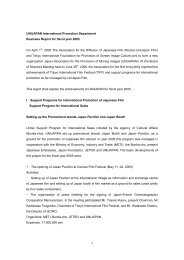The Guide to Japanese Film Industry & Co -Production - UNIJAPAN
The Guide to Japanese Film Industry & Co -Production - UNIJAPAN
The Guide to Japanese Film Industry & Co -Production - UNIJAPAN
Create successful ePaper yourself
Turn your PDF publications into a flip-book with our unique Google optimized e-Paper software.
Chapter 1<br />
Japan’s <strong>Film</strong> <strong>Industry</strong> Overview of the <strong>Japanese</strong> Box-office for Year 2008<br />
Overview of the <strong>Japanese</strong> Box-office for Year 2008<br />
1. <strong>Japanese</strong> <strong>Film</strong>s Exceed Imported <strong>Film</strong>s<br />
By Kakeo Yoshio, Executive Direc<strong>to</strong>r, Kinema Junpo <strong>Film</strong> Institute<br />
1) Attendance<br />
Although the <strong>Japanese</strong> film industry appears <strong>to</strong> be stable over the past<br />
decade, with both attendance and box-office receipts hovering with only<br />
slight ups or downs, it is actually entering difficult times as it can be seen in<br />
the continuing decline of attendance per-screen.<br />
In 2008, film attendance fell by 2.7 million in 2008, from 163.19<br />
million in 2007 <strong>to</strong> 160.49 million, or a slight drop <strong>to</strong> 98.34%. Box-office<br />
receipts also marked a similar small drop <strong>to</strong> 98.18%, falling by ¥3.607<br />
billion from ¥198.443 billion <strong>to</strong> ¥194.836 billion.<br />
Meanwhile, the number of screens increased by 138 from 3,221 in 2007<br />
<strong>to</strong> 3,359 in 2008. Multiplex cinemas increased <strong>to</strong> 2,659 screens, accounting<br />
for 79% of the <strong>to</strong>tal number of screens, up from 76% in 2007.<br />
Per-screen audience declined by 2,886 from 50,665 in 2007 <strong>to</strong> 47,779<br />
(94.30%), since attendance dropped while the number of screens increased.<br />
Likewise, per-screen box-office takings fell ¥3,604,961 from ¥61,609,128 in<br />
2007 <strong>to</strong> ¥58,004,167 in 2008 (94.14%).<br />
2) <strong>Film</strong>s released<br />
In 2008, 418 <strong>Japanese</strong> films and 388 imported films were released <strong>to</strong>taling<br />
806 films. This was a four-film-drop from 810 in 2007, among which 407<br />
were <strong>Japanese</strong> and 403 were imported films. <strong>The</strong>se numbers show also that<br />
in 2008 box-office receipts of <strong>Japanese</strong> films exceeded those of imported<br />
films by a large margin.<br />
While in 2006, the share of <strong>Japanese</strong> films over<strong>to</strong>ok that of imported<br />
films for the first time in 21 years, the margin was still small at 53% for<br />
<strong>Japanese</strong> films. In 2007, imported films recovered their share, albeit by<br />
a small margin, at 52%. In 2008, however, <strong>Japanese</strong> films overwhelmed<br />
imported films with a share of 59.46%.<br />
Although this was a welcome development for the <strong>Japanese</strong> film<br />
industry, a small decline in overall audience numbers showed that a large<br />
number of the audience for imported films simply shifted <strong>to</strong> <strong>Japanese</strong><br />
films. In other words, it justified that the future market will not expand<br />
unless both <strong>Japanese</strong> film and imported film attendance increases.<br />
2. Further Polarization between Majors and Independents<br />
1) Box-office draws<br />
In 2006 when the share of <strong>Japanese</strong> films first over<strong>to</strong>ok imported films,<br />
three films produced locally by Warner Entertainment Japan earned more<br />
than ¥10 billion in combined box-office takings. Likewise, both Asmik Ace<br />
Entertainment and Cine Qua Non had three titles with box-office takings<br />
of over ¥1 billion.<br />
In 2008, however, there were only two films with box-office takings<br />
of more than ¥1 billion released by non-big three makers—L change<br />
the WorLd by Warner (¥3.1 billion) and Climber’s High by Toei=Gaga<br />
<strong>Co</strong>mmunications (¥1.18 billion).<br />
<strong>The</strong> situation was the same for imported films, with the gap<br />
widening between major producers and independents. Financially weak<br />
independents find themselves in far more difficult conditions than major<br />
producers in terms of both planning and development costs and selection<br />
of plans.<br />
In other words, most big box-office draws came from major producers,<br />
with independents becoming less likely <strong>to</strong> come up with blockbuster hits.<br />
Several intertwined fac<strong>to</strong>rs are behind this development:<br />
(1) Multiplex cinemas, which now account for 80% of the <strong>to</strong>tal<br />
number of screens, are biased <strong>to</strong>ward showing big-hit films;<br />
(2) <strong>The</strong> dwindling secondary-use market makes it difficult <strong>to</strong> recover<br />
production costs of <strong>Japanese</strong> films and purchase costs of imported<br />
films, pushing financially fragile independents in<strong>to</strong> dire straits;<br />
(3) Tastes of audiences are changing: While older movie-goers enjoy<br />
diversified film cultures, younger film fans tend <strong>to</strong> favor largebudget<br />
<strong>Japanese</strong> films; and<br />
(4) Planning abilities of independents are waning.<br />
2) Major producers show growth<br />
Major producers joined hands with TV networks <strong>to</strong> take advantage of<br />
their strong information-transmitting capabilities <strong>to</strong> boost the visibility<br />
of films they make and thus put on the market such blockbuster hits as<br />
BOYS OVER FLOWERS the movie (Hana yori dango final) (¥7.75 billion/<br />
TBS), Suspect X (Yogisha X no kenshin) (¥4.92 billion/Fuji Television) and<br />
Partners: <strong>The</strong> Movie (Aibo —gekijoban—) (¥4.44 billion, TV Asahi). At<br />
the same time, they broadened their scope <strong>to</strong> take up more serious themes,<br />
including Departures (Okuribi<strong>to</strong>) (¥3 billion/TBS), I’d Rather Be a Shellfish<br />
(Watashi wa kai ni naritai) (2009/TBS) and Nobody <strong>to</strong> Watch over Me (Dare<br />
mo mamotte kurenai) (2008/Fuji Television).<br />
Another noteworthy development was the box-office draw of Detroit<br />
18 19




